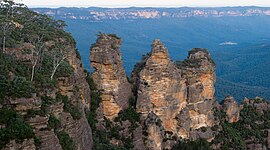Blue Mountains National Park
|
Blue Mountains National Park New South Wales |
|
|---|---|
|
IUCN category II (national park)
|
|

The Three Sisters, sandstone rock formations that are one of the best-known attractions in the region.
|
|
| Nearest town or city | Katoomba |
| Coordinates | 33°58′04″S 150°18′15″E / 33.96778°S 150.30417°ECoordinates: 33°58′04″S 150°18′15″E / 33.96778°S 150.30417°E |
| Established | September 1959 |
| Area | 2,679.54 km2 (1,034.6 sq mi) |
| Visitation | 563,000 (in 2009) |
| Managing authorities | NSW National Parks & Wildlife Service |
| Website | Blue Mountains National Park |
| See also | Protected areas of New South Wales |
The Blue Mountains National Park is a protected national park that is located in the Blue Mountains region of New South Wales, in eastern Australia. The 267,954-hectare (662,130-acre) national park is situated approximately 80 kilometres (50 mi) west of Sydney, and the park boundary is quite irregular as it is broken up by roads, urban areas and inholdings. Despite the name 'mountains', the area is an uplifted plateau, dissected by a number of larger rivers. The highest point in the park is Mount Werong at 1,215 metres (3,986 ft) above sea level; while the low point is on the Nepean River at 20 metres (66 ft) above sea level as it leaves the park.
The national park is one of the eight protected areas that, in 2000, was inscribed to form part of the UNESCO World Heritage–listed Greater Blue Mountains Area. The Blue Mountains National Park is the most central of the eight protected areas within the World Heritage Site and it forms part of the Great Dividing Range. The park is also listed on the Australian Heritage Register and the overall complex of Blue Mountains regional walking tracks is listed on the State Heritage Register.
The genesis of the national park was a proposal by early conservationist Myles Dunphy for a Greater Blue Mountains National Park in 1932. This included large areas of what are today the Blue Mountains National Park, and the Wollemi, Kanangra-Boyd, Nattai, Gardens of Stone, and Thirlmere Lakes, along with other smaller nature reserves; all managed by the NSW National Parks & Wildlife Service. In September 1959 the Blue Mountains National Park was gazetted covering 63,000 hectares (160,000 acres). In 2000 it was included as part of the Greater Blue Mountains World Heritage Area. In 1999, 37 walking tracks were added to the State Heritage Register, extending from Glenbrook and the Nepean River in the east; to Mount Tomah in the north; to Wolgan Valley and Newnes in the northwest; to Jenolan Caves and Oberon in the west; and in the south, numerous walks leading down the plateau from Katoomba, Leura and Wentworth Falls.
...
Wikipedia

